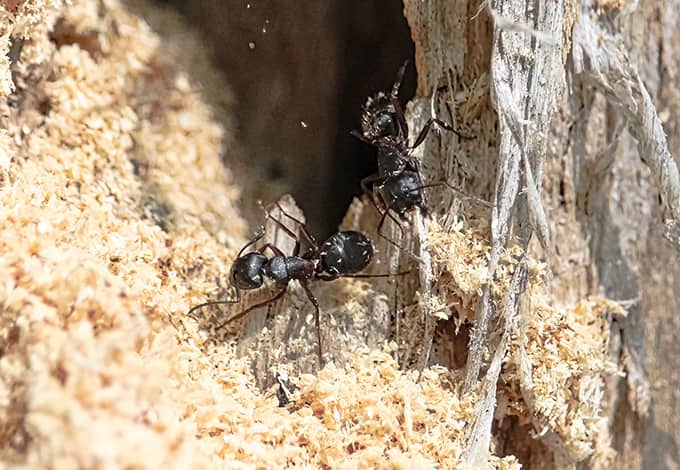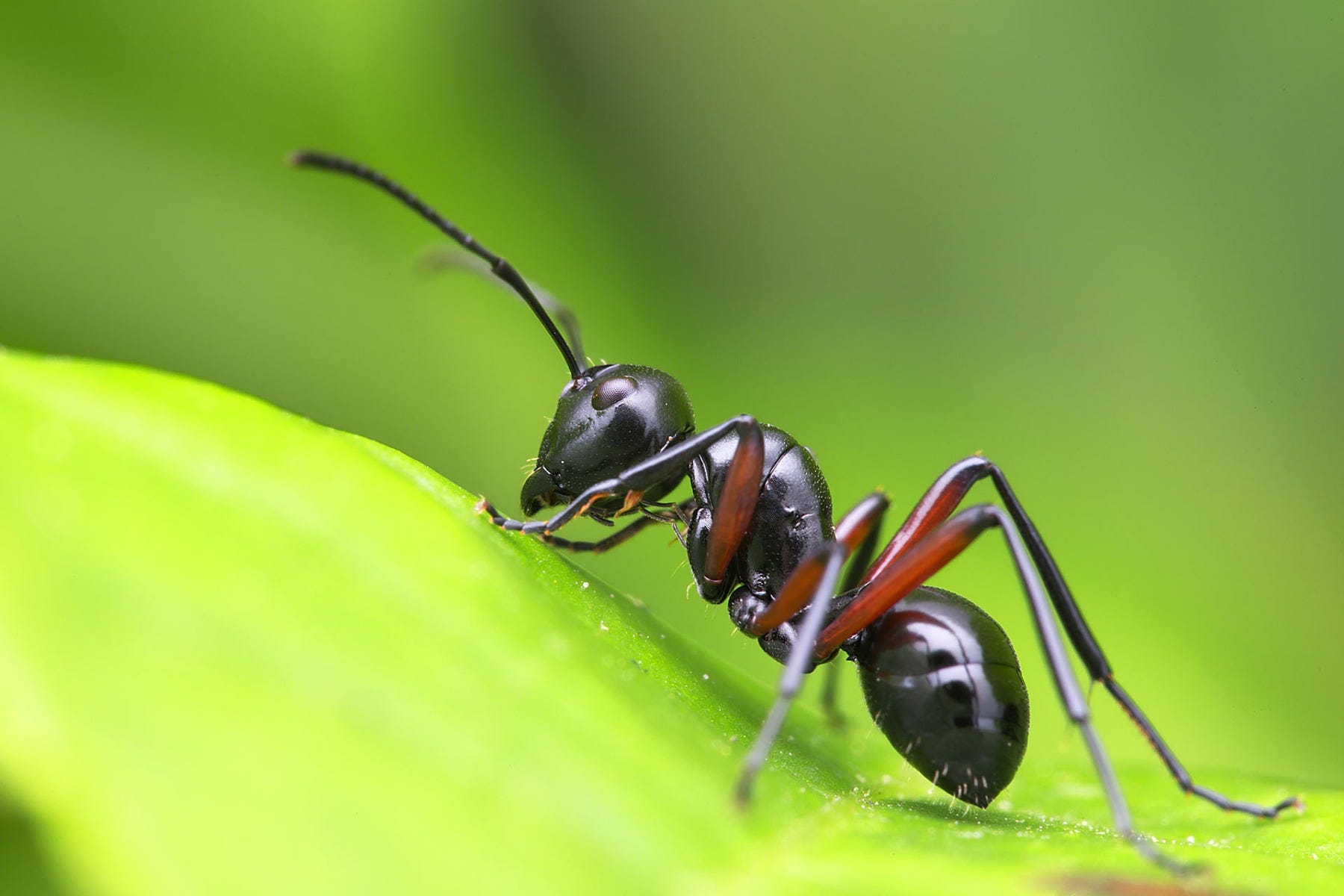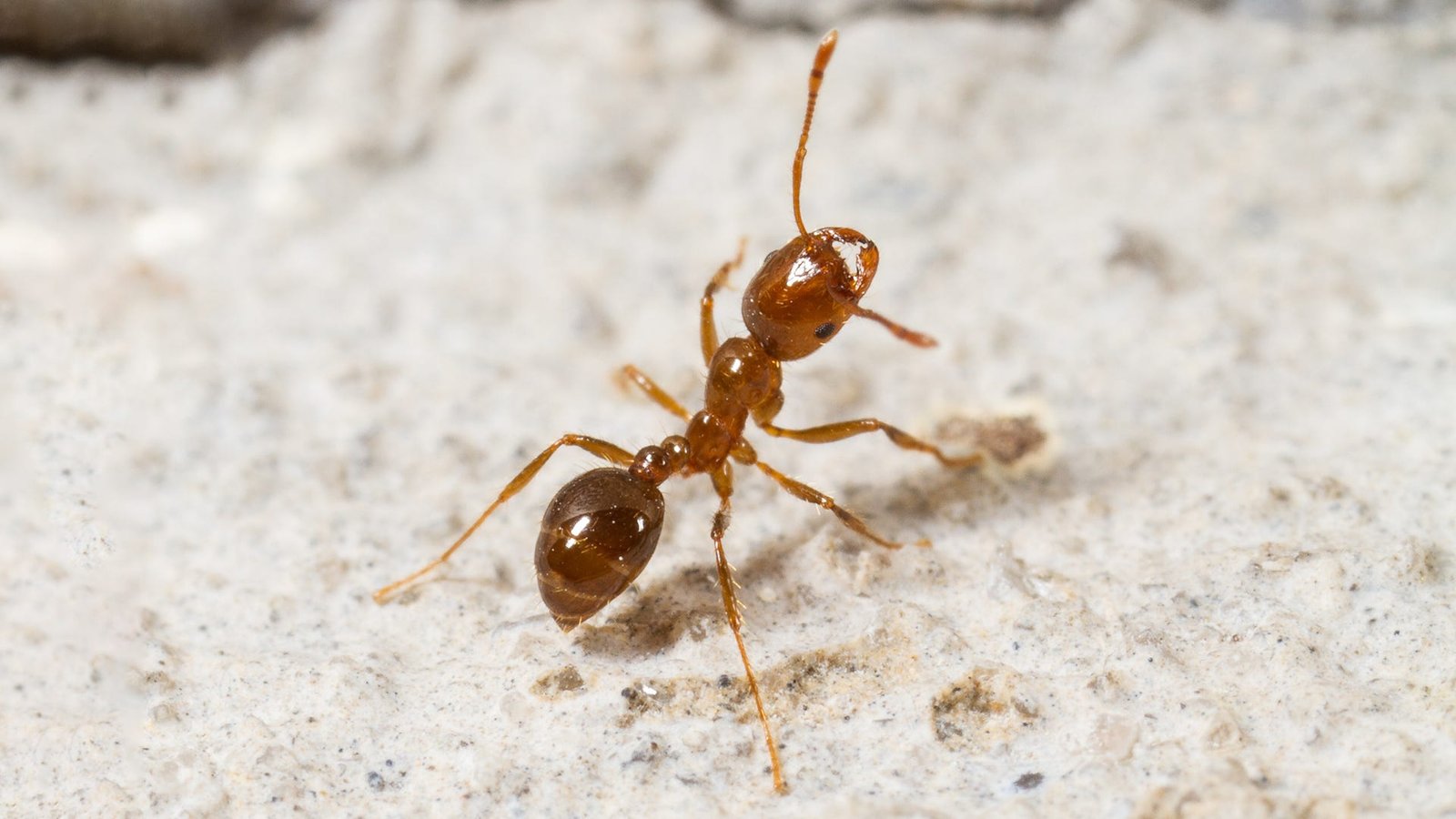During winter, ants enter a dormant state known as diapause, sheltering in their deep nests. They slow their metabolism and huddle together to conserve warmth and energy.
Ants are remarkable creatures that have mastered the art of survival in various climates. Their impressive adaptation skills allow them to thrive worldwide, with particular strategies for coping with cold weather. As temperatures drop, ants retreat from the surface, burrowing into the soil or finding solace inside logs or rocks.
This shift protects the colony from harsh conditions, ensuring their survival through reduced activity and metabolism. Understanding the winter habits of ants unveils a fascinating aspect of their life cycle, highlighting their resilience and intricate social structure that is often unnoticed during the bustling warmer months.

Credit: www.youtube.com
Ant Behavior In Cold Climates
When winter bites, ants showcase remarkable behavior to survive. These tiny insects adapt to the cold in ways that ensure their colony stays warm and has enough food until spring.
Coping With Temperature Drop
As temperatures fall, ants enter a state of dormancy. This is not true hibernation but a slowed-down state that conserves energy. During this period, they huddle together, reducing activity to keep the colony warm.
- Nest Insulation: Ants enhance their nests with materials that trap heat.
- Deep Burrowing: Some species dig deeper into the ground to reach warmer zones.
- Grouping: They cluster in large groups, pooling their body heat.
Seasonal Adaptations
Ants change their behavior with the seasons. In anticipation of cold weather, they gather extra food in late summer and early fall.
| Behavior | Purpose |
|---|---|
| Food Storage | Guarantee winter sustenance. |
| Queen Protection | Ensure the survival of the colony’s future. |
| Metabolic Slowdown | Conserve energy during inactivity. |
Their diet shifts to mostly carbohydrates, providing quick energy. Ants also produce glycerol, which acts like antifreeze, protecting them against freezing temperatures.
Ants’ Winter Survival Strategies
Ants’ Winter Survival Strategies are as unique as they are fascinating. As temperatures drop, these tiny creatures employ remarkable techniques to ensure their survival. Curious to know their secrets? Let’s delve into the world of ants during the frigid months.
Entering Diapause
When winter arrives, many ant species enter diapause. This is a state of suspended animation. Their metabolic rate drops dramatically. This allows them to conserve energy. During this time, ants require minimal food and water to survive.
- Metabolism slows down
- Non-essential systems shut off
- Survive with less resources
Group Hibernation Tactics
Ants also practice group hibernation tactics. They huddle together in their nests, deep beneath the ground. The nest’s location shields them from extreme cold. The collective body heat from the group keeps the nest warm.
| Strategy | Benefit |
|---|---|
| Deep underground nests | Protection from cold |
| Huddle in clusters | Shared body heat |
In these winter months, ants work together. This teamwork is key to their survival. The ant colony remains dormant, yet alive, ready to emerge in spring.
The Lifecycle Of Ants During Winter
As temperatures drop, you might wonder where all the ants have gone. Unlike birds migrating to warmer locations, ants have a unique survival strategy through the winter months. Their lifecycle enters a fascinating phase, often invisible to the curious eye but crucial for their survival. Let’s explore the roles within an ant colony during the chill of winter and uncover their secrets to braving the cold.
Queen Ants’ Role
Queen ants play a pivotal role in the colony’s longevity. As the sole egg layer, her survival is paramount.
- Begins a semi-hibernation state called diapause.
- Metabolic rate drops to conserve energy.
- Stays protected and insulated deep within the nest.
Ensuring the queen ant’s safety during winter guarantees the colony’s resurgence in spring.
Worker Ants’ Reduced Activity
The workforce of the ant colony, known as worker ants, adapt their roles significantly as winter sets in.
- Forage less due to scarce food sources.
- Physical activity decreases to minimize energy expenditure.
- Maintain and guard the nest from threats.
Worker ants cluster around the queen, using their body heat to keep the temperature steady. This collective effort keeps the colony alive until warmer days return.

Credit: www.parkwaypestservices.com
Physical Changes In Ants For Winter
As winter approaches, ants undergo fascinating transformations to survive the cold. These tiny insects adapt through physical and physiological changes. Let’s explore how ants prepare for winter through metabolic adjustments and body temperature regulation.
Metabolic Adjustments
Ants are experts at energy conservation. During the winter months, their metabolism slows down significantly. This shift allows the ants to use less energy and survive off their fat reserves. It is similar to how bears hibernate. The key difference is that ants remain somewhat active and awake.
- Decrease in food intake to minimize activity
- Build-up of fat reserves for energy supply
- Reduced movement to conserve energy
Body Temperature Regulation
Unlike humans, ants can’t generate their own body heat. They rely on the environment to regulate their temperature. In winter, ants cluster together in their nests. This behavior creates warmth and maintains a stable temperature within the nest.
| Strategy | Function |
|---|---|
| Clustering | Generates collective warmth |
| Deep burrowing | Access warmer ground temperatures |
| Reduced foraging | Minimizes exposure to cold |
By staying beneath the frost line, these insects harness the earth’s natural heat. This remarkable survival mechanism keeps them safe until the warmth of spring returns.
Nest Dynamics When Temperatures Fall
As the chill of winter approaches, ants undergo remarkable changes to survive the cold. Understanding how these tiny creatures ensure their survival can be truly fascinating. Let’s explore their subterranean world and uncover the secrets of their winter abodes.
Deep Burrowing Behavior
Ants adapt to dropping temperatures by moving their colonies deeper underground. This behavior keeps their nests away from the frost line, where soil temperatures remain warmer and more constant. Below the surface, ant communities stay active, although at a much slower pace than during the summer months.
Nest Insulation Techniques
To further combat the cold, ants display impressive skills in nest insulation. They utilize surrounding materials such as leaves, twigs, and earth to create barriers against the cold. The table below summarizes the common materials used for insulation:
| Material | Function |
|---|---|
| Leaves | Traps air and retains warmth |
| Twigs | Supports structure and provides cover |
| Soil | Absorbs moisture and maintains temperature |
By implementing these techniques, ants maintain a suitable microclimate within their nests that sustains them through the winter season. Without these adaptations, ants could not survive the harsh conditions brought on by winter.
The Impact Of Winter On Ant Food Sources
The Impact of Winter on Ant Food Sources alters the behavior of these tiny insects. Ants face several adversities during cold months, forcing them to adapt in fascinating ways. Their survival tactics regarding food are ingenious and critical for enduring the frigid season.
Foraging Challenges
Winter poses serious foraging challenges for ants. The drop in temperature causes many of their food sources to disappear. Plants wither, and insects either die or enter a dormant state. Ants must work twice as hard to locate food, often venturing further from their nests.
- Cold temperatures slow down ants’ movements.
- Fewer insects and plant materials are available.
- Frozen ground makes digging for food difficult.
Food Storage Methods
Ants anticipate the scarcity for food and employ food storage methods to survive. They stockpile food within their nests during warmer months. This ensures a supply to draw upon when outdoor foraging options are limited.
| Storage Strategy | Description |
|---|---|
| Gathering | Ants collect vast amounts of food in summer and autumn. |
| Conservation | Food use is minimized to make reserves last longer. |
| Regulation | Nests are kept at a certain humidity and temperature to preserve food. |
Research Insights Into Ant Winterization
As winter approaches, the bustling activity of ants slows and curiosity arises: where do these tiny creatures go? Research into the winter behavior of ants unveils an incredible journey of survival and adaptation. Both amateur entomologists and professional researchers share a fascination with ant winterization strategies, leading to insightful discoveries.
Scientific Observations
Entomologists use meticulous methods to track ant populations as the cold sets in. Ants show remarkable ingenuity in their survival tactics. Scientists have documented that many species retreat deep underground to escape the chill. There, they enter a state akin to hibernation known as diapause, significantly slowing their metabolism.
Studies On Ant Cold Tolerance
- Species Specificity: Different ant species exhibit varying levels of cold weather tolerance, suggesting a genetic adaptation to their environments.
- Temperature Thresholds: Research indicates clear thresholds below which ants cannot survive; these limits often dictate the depth of their winter burrows.
- Mobility and Feeding: Studies show a drastic reduction in mobility and feeding as temperatures drop, which conserves energy during the lean months.
These insights are not merely academic; they contribute to a deeper understanding of biodiversity and survival strategies in the insect world. Understanding the winter behavior of ants enhances our appreciation for these tiny yet resilient creatures.
Human-ant Interactions In Colder Months
As the cold sets in, you might wonder about the ants that busied about in your backyard. Ants and humans cross paths often, even in winter. Let’s explore how these tiny creatures adapt and how our interactions with them change during the colder months.
Ants In Domestic Environments
In search of warmth and food, ants may find their way into your home. They nest in walls or under floors. Kitchens and bathrooms often harbor these uninvited guests. Ant colonies hibernate, but your home’s warmth may trick them into thinking it’s still summer.
- Walls and baseboards: Possible ant hideouts.
- Cracks and crevices: Entry points for ants.
- Warm pipes and heaters: Ant magnets in winter.
Dealing With Ant Invasions During Winter
Noticing ants in colder months can be surprising. Dealing with them requires patience and persistence. Here are steps to keep ants away:
- Seal openings: Stops more ants from entering.
- Clean spills: Reduces food sources for ants.
- Bait stations: Targets the colony without spreading pesticides everywhere.
Ants indoors mean they’ve found warmth and possibly a food supply. Maintaining cleanliness and blocking entry points are essential strategies. If the problem persists, seek professional pest control.
Natural Predators Of Ants In The Winter
As winter wraps the world in its chilly embrace, ants face a critical challenge. They must survive not only the cold but also the threats posed by natural predators. Let’s explore who these cold-weather hunters are and how ants defend themselves.
Predatory Practices In Cold Weather
In winter, many creatures are on the lookout for a meal, and ants can be on the menu. Predators such as birds, spiders, and frogs adapt to colder climates by following ants into their colonies or capturing them during rare appearances on the snow-laden ground.
| Predator | Strategy |
|---|---|
| Birds | Seek ant hills, peck through snow |
| Spiders | Lurk near nests, snatch unwary ants |
| Frogs | Wait for ants in warm microclimates |
Ant Defense Mechanisms
Despite the risks, ants employ several tactics to stay safe. They hibernate, grouping together to maintain warmth and conserve energy. If predators infiltrate, ants use their mandibles to fight back or flee to deeper, warmer chambers in their nests.
- Hibernation – Clumping in groups for survival.
- Mandibles – Biting as a method of self-defense.
- Deeper Chambers – Escaping to safe zones within the colony.

Credit: www.terro.com
Global Perspectives On Winter Ant Behavior
Exploring how ants survive the cold reveals a fascinating tale of adaptation and survival. While humans bundle up and retreat indoors, ants have their unique strategies for dealing with winter’s chill. Globally, ant behavior during winter varies, influenced by regional climates and specific species capabilities. In this section, we will explore how these tiny creatures cope with winter in different parts of the world.
Ant Activity In Temperate Vs. Polar Regions
In temperate regions, ants employ a technique called ‘overwintering.’ As temperatures drop, ant metabolism slows down, prompting them to retreat to their nests. These subterranean fortresses can be meters deep, with the depth and insulation providing adequate warmth for survival. Ants huddle together, sharing body heat and conserving energy until spring.
In stark contrast, ants in polar regions face harsher conditions. Here, the concept of overwintering extends to extreme lengths. These ants enter a state called diapause, a deeper, more prolonged dormancy period. Some species, like the Arctic ant, can withstand freezing temperatures by employing special proteins that act as antifreeze, preventing ice crystal formation in their bodies.
Behavioral Differences Across Species
Not all ants approach winter equally. Different species have different survival tactics. The common black ant, for instance, clumps together in large numbers, reducing exposure to the cold. On the other hand, the wood ant constructs massive mounds with precise ventilation channels to regulate temperature and humidity.
Some tropical ants, not acclimated to cold, remain active year-round. Their challenge is not the cold, but the wet season. They adapt by building waterproof nests or living in arboreal habitats, away from the flood-prone ground. This behavior emphasizes the diversity and adaptability of ant species across climates.
| Ant Species | Winter Adaptation | Region |
|---|---|---|
| Temperate Wood Ant | Mound Building | Temperate Forests |
| Arctic Ant | Diapause | Polar Regions |
| Tropical Ant | Waterproof Nesting | Tropical Forests |
Understanding these varied survival strategies enlightens us about the remarkable ways in which ants have evolved. Whether it’s the deep nests of temperate ants or the antifreeze proteins of polar species, ants demonstrate resilience in the face of winter’s adversity.
Frequently Asked Questions On Where Do Ants Go In The Winter
Do Ants Hibernate Like Bears Do?
No, ants do not hibernate in the same way bears do. Instead, during winter, they enter a state of dormancy. This is known as diapause. They slow down their metabolism and reduce their activity to conserve energy until warmer conditions return.
Where Can Ants Be Found During Winter?
In winter, ants typically retreat to their nests deep underground, beneath rocks, or inside logs. They seek environments that are less susceptible to freezing temperatures. This allows them to maintain a controlled climate, shielding them from the harsh winter conditions outside.
How Do Ants Survive The Cold Of Winter?
Ants survive winter by congregating in their nests and relying on their collective body heat. They feed on stored food and fats. Their activity is greatly reduced, which lowers their need for food and helps them conserve energy until the temperatures rise again.
What Changes Occur In Ant Behavior In Winter?
During winter, ant behavior shifts significantly. They become less active, stop foraging, and focus on maintaining warmth within the nest. The queen’s egg production also slows down or pauses until spring, aligning their life cycle with the seasons.
Conclusion
As winter approaches, ants showcase remarkable adaptability. They retreat to deep burrows, enter a state of dormancy, or rely on their collected resources. These tiny survivors exemplify resilience in the face of cold. Come spring, they’ll emerge once again, ready to thrive in a renewed world.
Remember, the secret to their success lies beneath the surface!

I’m MD Tanvir, and I bring years of expertise gained from working closely with pest control companies to the forefront. My journey in the industry has inspired me to launch Bug Battler, a platform aimed at equipping people with the know-how to combat pests autonomously. Through Bug Battler, I aim to empower individuals with practical insights to tackle pest infestations effectively.

